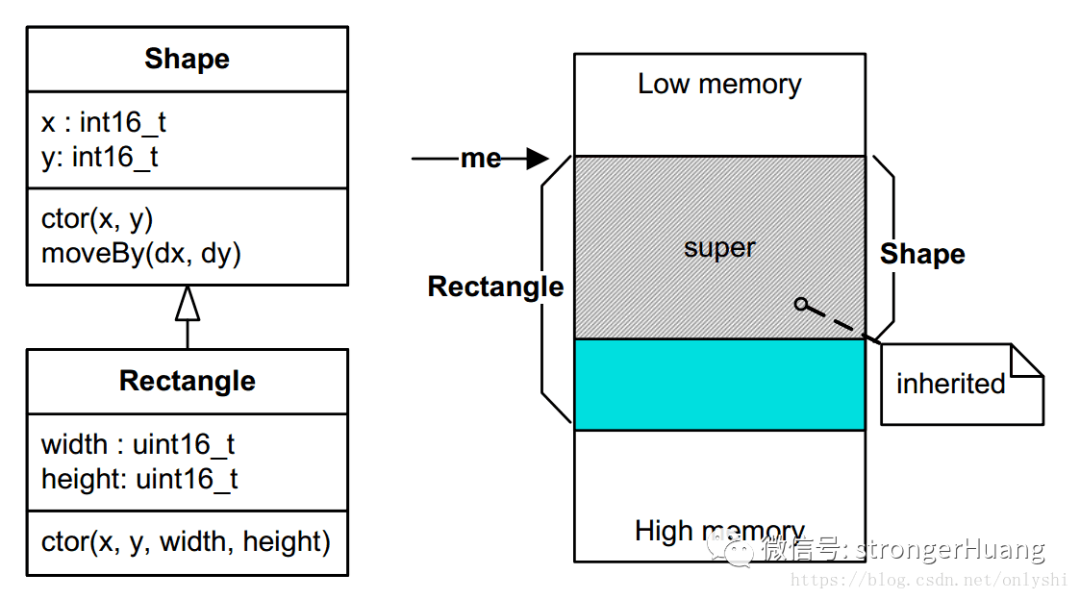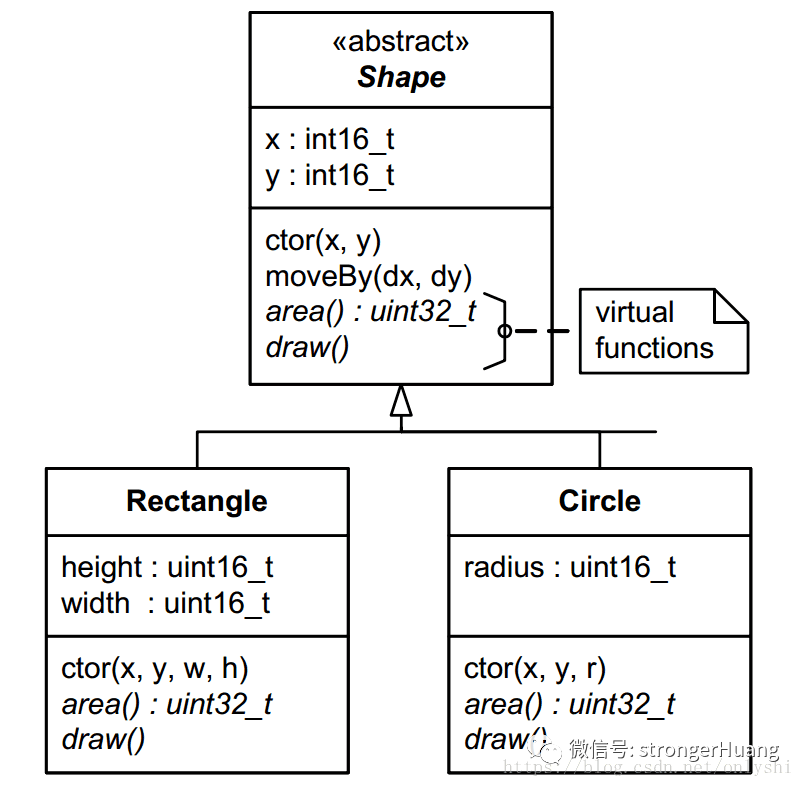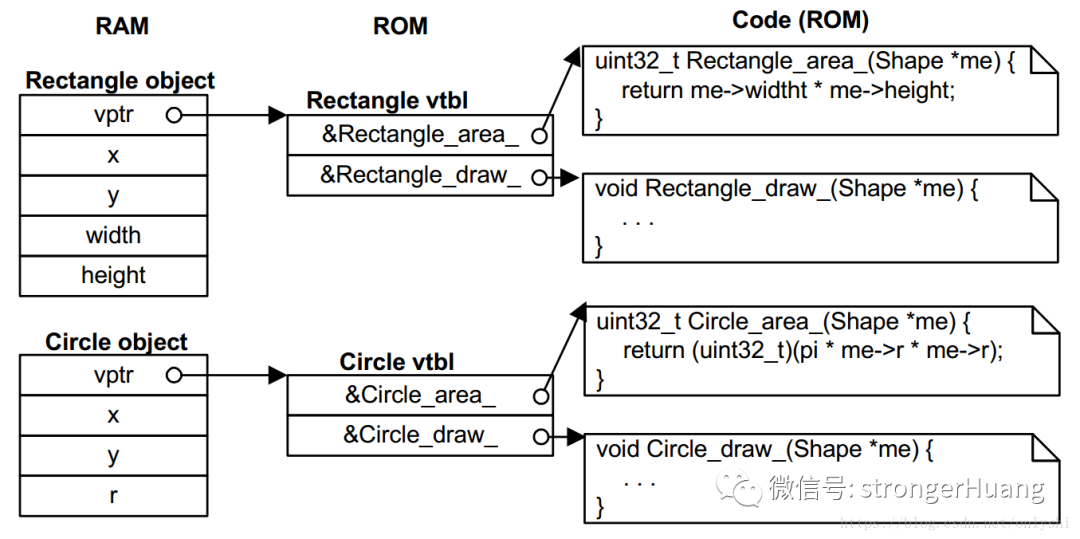不知道有多少人去了解過語言的發(fā)展史,早期C語言的語法功能其實(shí)比較簡單。隨著應(yīng)用需求和場景的變化,C語言的語法功能在不斷升級(jí)變化。
雖然我們的教材有這么一個(gè)結(jié)論:C語言是面向過程的語言,C++是面向?qū)ο蟮?a target="_blank">編程語言,但面向?qū)ο蟮母拍钍窃贑語言階段就有了,而且應(yīng)用到了很多地方,比如某些操作系統(tǒng)內(nèi)核、通信協(xié)議等。
面向?qū)ο缶幊蹋簿褪谴蠹艺f的OOP(Object Oriented Programming)并不是一種特定的語言或者工具,它只是一種設(shè)計(jì)方法、設(shè)計(jì)思想,它表現(xiàn)出來的三個(gè)最基本的特性就是封裝、繼承與多態(tài)。
為什么要用C語言實(shí)現(xiàn)面向?qū)ο?/strong>
閱讀文本之前肯定有讀者會(huì)問這樣的問題:我們有C++面向?qū)ο蟮恼Z言,為什么還要用C語言實(shí)現(xiàn)面向?qū)ο竽兀?/p>
C語言這種非面向?qū)ο蟮恼Z言,同樣也可以使用面向?qū)ο蟮乃悸穪砭帉懗绦虻摹V皇怯妹嫦驅(qū)ο蟮腃++語言來實(shí)現(xiàn)面向?qū)ο缶幊虝?huì)更簡單一些,但是C語言的高效性是其他面向?qū)ο缶幊陶Z言無法比擬的。
當(dāng)然使用C語言來實(shí)現(xiàn)面向?qū)ο蟮拈_發(fā)相對不容易理解,這就是為什么大多數(shù)人學(xué)過C語言卻看不懂Linux內(nèi)核源碼。
所以這個(gè)問題其實(shí)很好理解,只要有一定C語言編程經(jīng)驗(yàn)的讀者都應(yīng)該能明白:面向過程的C語言和面向?qū)ο蟮腃++語言相比,代碼運(yùn)行效率、代碼量都有很大差異。在性能不是很好、資源不是很多的MCU中使用C語言面向?qū)ο缶幊叹惋@得尤為重要。
具備條件
要想使用C語言實(shí)現(xiàn)面向?qū)ο螅紫刃枰邆湟恍┗A(chǔ)知識(shí)。比如:(C語言中的)結(jié)構(gòu)體、函數(shù)、指針,以及函數(shù)指針等,(C++中的)基類、派生、多態(tài)、繼承等。
首先,不僅僅是了解這些基礎(chǔ)知識(shí),而是有一定的編程經(jīng)驗(yàn),因?yàn)樯厦嬲f了“面向?qū)ο笫且环N設(shè)計(jì)方法、設(shè)計(jì)思想”,如果只是停留在字面意思的理解,沒有這種設(shè)計(jì)思想肯定不行。
因此,不建議初學(xué)者使用C語言實(shí)現(xiàn)面向?qū)ο螅貏e是在真正項(xiàng)目中。建議把基本功練好,再使用。
利用C語言實(shí)現(xiàn)面向?qū)ο蟮姆椒ê芏啵旅婢蛠砻枋鲎罨镜姆庋b、繼承和多態(tài)。
封裝
封裝就是把數(shù)據(jù)和函數(shù)打包到一個(gè)類里面,其實(shí)大部分C語言編程者都已近接觸過了。
C 標(biāo)準(zhǔn)庫中的 fopen(), fclose(), fread(), fwrite()等函數(shù)的操作對象就是 FILE。數(shù)據(jù)內(nèi)容就是 FILE,數(shù)據(jù)的讀寫操作就是 fread()、fwrite(),fopen() 類比于構(gòu)造函數(shù),fclose() 就是析構(gòu)函數(shù)。
這個(gè)看起來似乎很好理解,那下面我們實(shí)現(xiàn)一下基本的封裝特性。
#ifndef SHAPE_H #define SHAPE_H #include// Shape 的屬性 typedef struct { int16_t x; int16_t y; } Shape; // Shape 的操作函數(shù),接口函數(shù) void Shape_ctor(Shape * const me, int16_t x, int16_t y); void Shape_moveBy(Shape * const me, int16_t dx, int16_t dy); int16_t Shape_getX(Shape const * const me); int16_t Shape_getY(Shape const * const me); #endif /* SHAPE_H */
這是 Shape 類的聲明,非常簡單,很好理解。一般會(huì)把聲明放到頭文件里面 “Shape.h”。來看下 Shape 類相關(guān)的定義,當(dāng)然是在 “Shape.c” 里面。
#include "shape.h"
// 構(gòu)造函數(shù)
void Shape_ctor(Shape * const me, int16_t x, int16_t y)
{
me->x = x;
me->y = y;
}
void Shape_moveBy(Shape * const me, int16_t dx, int16_t dy)
{
me->x += dx;
me->y += dy;
}
// 獲取屬性值函數(shù)
int16_t Shape_getX(Shape const * const me)
{
return me->x;
}
int16_t Shape_getY(Shape const * const me)
{
return me->y;
}
再看下 main.c
#include "shape.h" /* Shape class interface */ #include編譯之后,看看執(zhí)行結(jié)果:/* for printf() */ int main() { Shape s1, s2; /* multiple instances of Shape */ Shape_ctor(&s1, 0, 1); Shape_ctor(&s2, -1, 2); printf("Shape s1(x=%d,y=%d) ", Shape_getX(&s1), Shape_getY(&s1)); printf("Shape s2(x=%d,y=%d) ", Shape_getX(&s2), Shape_getY(&s2)); Shape_moveBy(&s1, 2, -4); Shape_moveBy(&s2, 1, -2); printf("Shape s1(x=%d,y=%d) ", Shape_getX(&s1), Shape_getY(&s1)); printf("Shape s2(x=%d,y=%d) ", Shape_getX(&s2), Shape_getY(&s2)); return 0; }
Shape s1(x=0,y=1) Shape s2(x=-1,y=2) Shape s1(x=2,y=-3) Shape s2(x=0,y=0)
整個(gè)例子,非常簡單,非常好理解。以后寫代碼時(shí)候,要多去想想標(biāo)準(zhǔn)庫的文件IO操作,這樣也有意識(shí)的去培養(yǎng)面向?qū)ο缶幊痰乃季S。
繼承
繼承就是基于現(xiàn)有的一個(gè)類去定義一個(gè)新類,這樣有助于重用代碼,更好的組織代碼。在 C 語言里面,去實(shí)現(xiàn)單繼承也非常簡單,只要把基類放到繼承類的第一個(gè)數(shù)據(jù)成員的位置就行了。
例如,我們現(xiàn)在要?jiǎng)?chuàng)建一個(gè) Rectangle 類,我們只要繼承 Shape 類已經(jīng)存在的屬性和操作,再添加不同于 Shape 的屬性和操作到 Rectangle 中。
下面是 Rectangle 的聲明與定義:
#ifndef RECT_H
#define RECT_H
#include "shape.h" // 基類接口
// 矩形的屬性
typedef struct {
Shape super; // 繼承 Shape
// 自己的屬性
uint16_t width;
uint16_t height;
} Rectangle;
// 構(gòu)造函數(shù)
void Rectangle_ctor(Rectangle * const me, int16_t x, int16_t y,
uint16_t width, uint16_t height);
#endif /* RECT_H */
#include "rect.h"
// 構(gòu)造函數(shù)
void Rectangle_ctor(Rectangle * const me, int16_t x, int16_t y,
uint16_t width, uint16_t height)
{
/* first call superclass’ ctor */
Shape_ctor(&me->super, x, y);
/* next, you initialize the attributes added by this subclass... */
me->width = width;
me->height = height;
}
我們來看一下 Rectangle 的繼承關(guān)系和內(nèi)存布局:
因?yàn)橛羞@樣的內(nèi)存布局,所以你可以很安全的傳一個(gè)指向 Rectangle 對象的指針到一個(gè)期望傳入 Shape 對象的指針的函數(shù)中,就是一個(gè)函數(shù)的參數(shù)是 “Shape *”,你可以傳入 “Rectangle *”,并且這是非常安全的。這樣的話,基類的所有屬性和方法都可以被繼承類繼承!
#include "rect.h" #includeint main() { Rectangle r1, r2; // 實(shí)例化對象 Rectangle_ctor(&r1, 0, 2, 10, 15); Rectangle_ctor(&r2, -1, 3, 5, 8); printf("Rect r1(x=%d,y=%d,width=%d,height=%d) ", Shape_getX(&r1.super), Shape_getY(&r1.super), r1.width, r1.height); printf("Rect r2(x=%d,y=%d,width=%d,height=%d) ", Shape_getX(&r2.super), Shape_getY(&r2.super), r2.width, r2.height); // 注意,這里有兩種方式,一是強(qiáng)轉(zhuǎn)類型,二是直接使用成員地址 Shape_moveBy((Shape *)&r1, -2, 3); Shape_moveBy(&r2.super, 2, -1); printf("Rect r1(x=%d,y=%d,width=%d,height=%d) ", Shape_getX(&r1.super), Shape_getY(&r1.super), r1.width, r1.height); printf("Rect r2(x=%d,y=%d,width=%d,height=%d) ", Shape_getX(&r2.super), Shape_getY(&r2.super), r2.width, r2.height); return 0; }
輸出結(jié)果:
Rect r1(x=0,y=2,width=10,height=15) Rect r2(x=-1,y=3,width=5,height=8) Rect r1(x=-2,y=5,width=10,height=15) Rect r2(x=1,y=2,width=5,height=8)
多態(tài)
C++ 語言實(shí)現(xiàn)多態(tài)就是使用虛函數(shù)。在 C 語言里面,也可以實(shí)現(xiàn)多態(tài)。 現(xiàn)在,我們又要增加一個(gè)圓形,并且在 Shape 要擴(kuò)展功能,我們要增加 area() 和 draw() 函數(shù)。但是 Shape 相當(dāng)于抽象類,不知道怎么去計(jì)算自己的面積,更不知道怎么去畫出來自己。而且,矩形和圓形的面積計(jì)算方式和幾何圖像也是不一樣的。 下面讓我們重新聲明一下 Shape 類:
#ifndef SHAPE_H #define SHAPE_H #includestruct ShapeVtbl; // Shape 的屬性 typedef struct { struct ShapeVtbl const *vptr; int16_t x; int16_t y; } Shape; // Shape 的虛表 struct ShapeVtbl { uint32_t (*area)(Shape const * const me); void (*draw)(Shape const * const me); }; // Shape 的操作函數(shù),接口函數(shù) void Shape_ctor(Shape * const me, int16_t x, int16_t y); void Shape_moveBy(Shape * const me, int16_t dx, int16_t dy); int16_t Shape_getX(Shape const * const me); int16_t Shape_getY(Shape const * const me); static inline uint32_t Shape_area(Shape const * const me) { return (*me->vptr->area)(me); } static inline void Shape_draw(Shape const * const me) { (*me->vptr->draw)(me); } Shape const *largestShape(Shape const *shapes[], uint32_t nShapes); void drawAllShapes(Shape const *shapes[], uint32_t nShapes); #endif/*SHAPE_H*/
看下加上虛函數(shù)之后的類關(guān)系圖:

5.1 虛表和虛指針
虛表(Virtual Table)是這個(gè)類所有虛函數(shù)的函數(shù)指針的集合。 虛指針(Virtual Pointer)是一個(gè)指向虛表的指針。這個(gè)虛指針必須存在于每個(gè)對象實(shí)例中,會(huì)被所有子類繼承。 在《Inside The C++ Object Model》的第一章內(nèi)容中,有這些介紹。
5.2 在構(gòu)造函數(shù)中設(shè)置vptr
在每一個(gè)對象實(shí)例中,vptr 必須被初始化指向其 vtbl。最好的初始化位置就是在類的構(gòu)造函數(shù)中。事實(shí)上,在構(gòu)造函數(shù)中,C++ 編譯器隱式的創(chuàng)建了一個(gè)初始化的vptr。在 C 語言里面, 我們必須顯示的初始化vptr。 下面就展示一下,在 Shape 的構(gòu)造函數(shù)里面,如何去初始化這個(gè) vptr。
#include "shape.h" #include5.3 繼承 vtbl 和 重載 vptr// Shape 的虛函數(shù) static uint32_t Shape_area_(Shape const * const me); static void Shape_draw_(Shape const * const me); // 構(gòu)造函數(shù) void Shape_ctor(Shape * const me, int16_t x, int16_t y) { // Shape 類的虛表 static struct ShapeVtbl const vtbl = { &Shape_area_, &Shape_draw_ }; me->vptr = &vtbl; me->x = x; me->y = y; } void Shape_moveBy(Shape * const me, int16_t dx, int16_t dy) { me->x += dx; me->y += dy; } int16_t Shape_getX(Shape const * const me) { return me->x; } int16_t Shape_getY(Shape const * const me) { return me->y; } // Shape 類的虛函數(shù)實(shí)現(xiàn) static uint32_t Shape_area_(Shape const * const me) { assert(0); // 類似純虛函數(shù) return 0U; // 避免警告 } static void Shape_draw_(Shape const * const me) { assert(0); // 純虛函數(shù)不能被調(diào)用 } Shape const *largestShape(Shape const *shapes[], uint32_t nShapes) { Shape const *s = (Shape *)0; uint32_t max = 0U; uint32_t i; for (i = 0U; i < nShapes; ++i) { uint32_t area = Shape_area(shapes[i]);// 虛函數(shù)調(diào)用 if (area > max) { max = area; s = shapes[i]; } } return s; } void drawAllShapes(Shape const *shapes[], uint32_t nShapes) { uint32_t i; for (i = 0U; i < nShapes; ++i) { Shape_draw(shapes[i]); // 虛函數(shù)調(diào)用 } }
上面已經(jīng)提到過,基類包含 vptr,子類會(huì)自動(dòng)繼承。但是,vptr 需要被子類的虛表重新賦值。并且,這也必須發(fā)生在子類的構(gòu)造函數(shù)中。下面是 Rectangle 的構(gòu)造函數(shù)。
#include "rect.h" #include// Rectangle 虛函數(shù) static uint32_t Rectangle_area_(Shape const * const me); static void Rectangle_draw_(Shape const * const me); // 構(gòu)造函數(shù) void Rectangle_ctor(Rectangle * const me, int16_t x, int16_t y, uint16_t width, uint16_t height) { static struct ShapeVtbl const vtbl = { &Rectangle_area_, &Rectangle_draw_ }; Shape_ctor(&me->super, x, y); // 調(diào)用基類的構(gòu)造函數(shù) me->super.vptr = &vtbl; // 重載 vptr me->width = width; me->height = height; } // Rectangle's 虛函數(shù)實(shí)現(xiàn) static uint32_t Rectangle_area_(Shape const * const me) { Rectangle const * const me_ = (Rectangle const *)me; //顯示的轉(zhuǎn)換 return (uint32_t)me_->width * (uint32_t)me_->height; } static void Rectangle_draw_(Shape const * const me) { Rectangle const * const me_ = (Rectangle const *)me; //顯示的轉(zhuǎn)換 printf("Rectangle_draw_(x=%d,y=%d,width=%d,height=%d) ", Shape_getX(me), Shape_getY(me), me_->width, me_->height); }
5.4 虛函數(shù)調(diào)用
有了前面虛表(Virtual Tables)和虛指針(Virtual Pointers)的基礎(chǔ)實(shí)現(xiàn),虛擬調(diào)用(后期綁定)就可以用下面代碼實(shí)現(xiàn)了。
uint32_t Shape_area(Shape const * const me)
{
return (*me->vptr->area)(me);
}
這個(gè)函數(shù)可以放到.c文件里面,但是會(huì)帶來一個(gè)缺點(diǎn)就是每個(gè)虛擬調(diào)用都有額外的調(diào)用開銷。為了避免這個(gè)缺點(diǎn),如果編譯器支持內(nèi)聯(lián)函數(shù)(C99)。我們可以把定義放到頭文件里面,類似下面:
static inline uint32_t Shape_area(Shape const * const me)
{
return (*me->vptr->area)(me);
}
如果是老一點(diǎn)的編譯器(C89),我們可以用宏函數(shù)來實(shí)現(xiàn),類似下面這樣:
#define Shape_area(me_) ((*(me_)->vptr->area)((me_)))看一下例子中的調(diào)用機(jī)制:
 ? 5.5 main.c
? 5.5 main.c
#include "rect.h" #include "circle.h" #include輸出結(jié)果:int main() { Rectangle r1, r2; Circle c1, c2; Shape const *shapes[] = { &c1.super, &r2.super, &c2.super, &r1.super }; Shape const *s; // 實(shí)例化矩形對象 Rectangle_ctor(&r1, 0, 2, 10, 15); Rectangle_ctor(&r2, -1, 3, 5, 8); // 實(shí)例化圓形對象 Circle_ctor(&c1, 1, -2, 12); Circle_ctor(&c2, 1, -3, 6); s = largestShape(shapes, sizeof(shapes)/sizeof(shapes[0])); printf("largetsShape s(x=%d,y=%d) ", Shape_getX(s), Shape_getY(s)); drawAllShapes(shapes, sizeof(shapes)/sizeof(shapes[0])); return 0; }
largetsShape s(x=1,y=-2) Circle_draw_(x=1,y=-2,rad=12) Rectangle_draw_(x=-1,y=3,width=5,height=8) Circle_draw_(x=1,y=-3,rad=6) Rectangle_draw_(x=0,y=2,width=10,height=15)
總結(jié)
還是那句話,面向?qū)ο缶幊淌且环N方法,并不局限于某一種編程語言。用 C 語言實(shí)現(xiàn)封裝、單繼承,理解和實(shí)現(xiàn)起來比較簡單,多態(tài)反而會(huì)稍微復(fù)雜一點(diǎn),如果打算廣泛的使用多態(tài),還是推薦轉(zhuǎn)到 C++ 語言上,畢竟這層復(fù)雜性被這個(gè)語言給封裝了,你只需要簡單的使用就行了。但并不代表,C 語言實(shí)現(xiàn)不了多態(tài)這個(gè)特性。
審核編輯:湯梓紅。
-
Linux
+關(guān)注
關(guān)注
87文章
11325瀏覽量
209954 -
C語言
+關(guān)注
關(guān)注
180文章
7611瀏覽量
137233 -
源碼
+關(guān)注
關(guān)注
8文章
648瀏覽量
29310 -
C++
+關(guān)注
關(guān)注
22文章
2113瀏覽量
73738 -
面向?qū)ο?/span>
+關(guān)注
關(guān)注
0文章
64瀏覽量
9994
原文標(biāo)題:C語言實(shí)現(xiàn)面向?qū)ο蟮姆椒?/p>
文章出處:【微信號(hào):mcu168,微信公眾號(hào):硬件攻城獅】歡迎添加關(guān)注!文章轉(zhuǎn)載請注明出處。
發(fā)布評(píng)論請先 登錄
相關(guān)推薦
C語言實(shí)現(xiàn)面向對象的方式 C++中的class的運(yùn)行原理
嵌入式C語言面向對象編程---多態(tài)
如何用C語言實(shí)現(xiàn)面向對象編程
C++語言和面向對象程序設(shè)計(jì)教程
如何用C語言實(shí)現(xiàn)面向對象編程OOP?
為什么要用C語言實(shí)現(xiàn)面向對象

用C語言實(shí)現(xiàn)簡單工廠模式





 C語言實(shí)現(xiàn)面向?qū)ο蟮姆椒?/h1>
C語言實(shí)現(xiàn)面向?qū)ο蟮姆椒?/h1>















評(píng)論